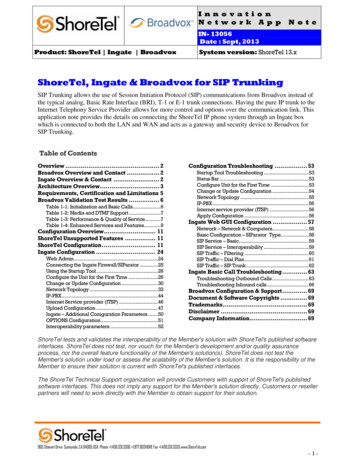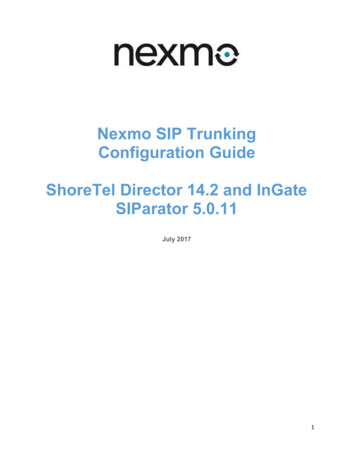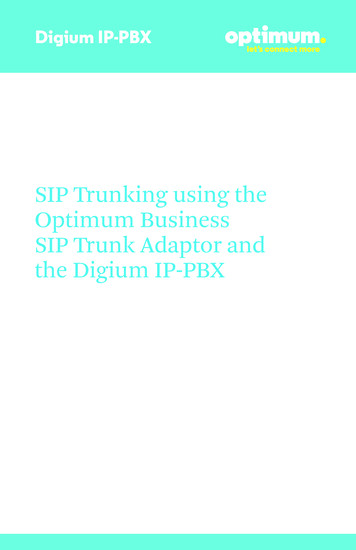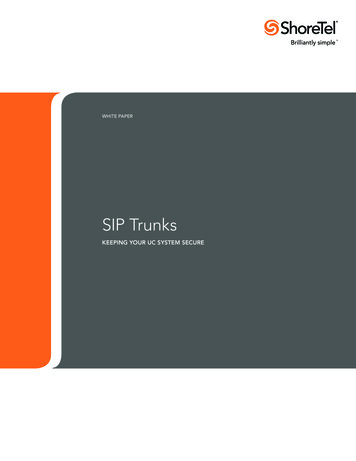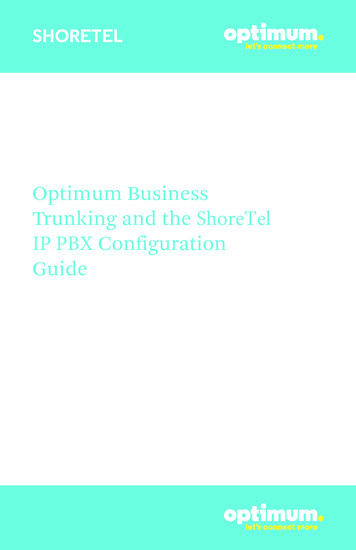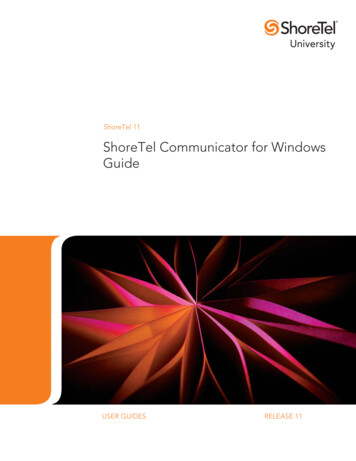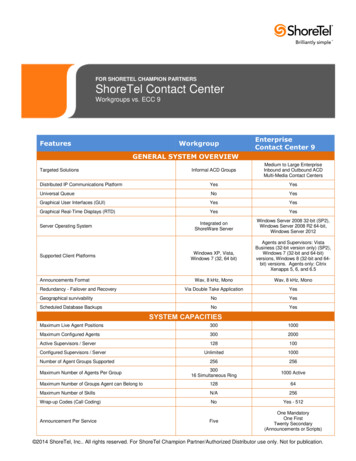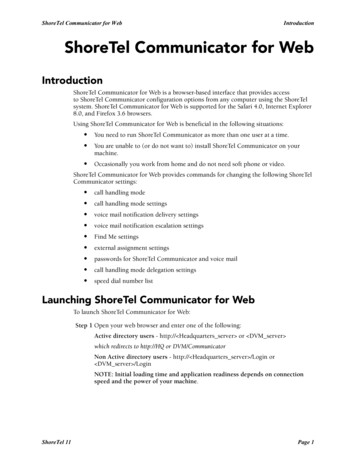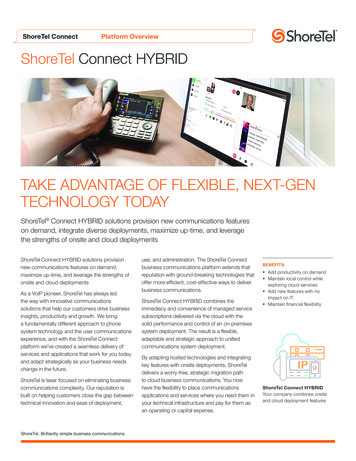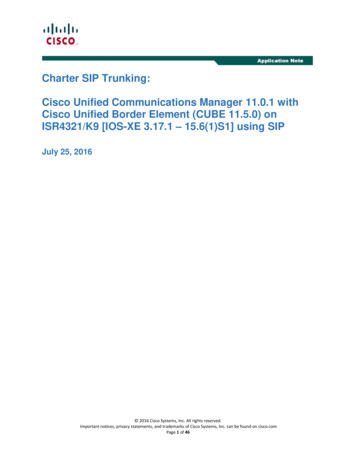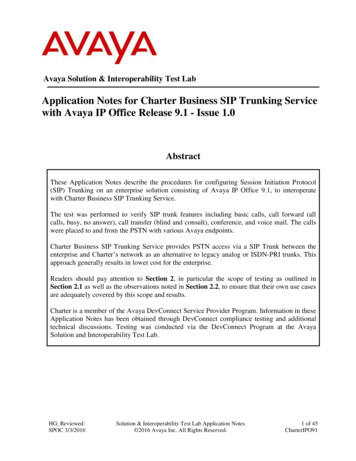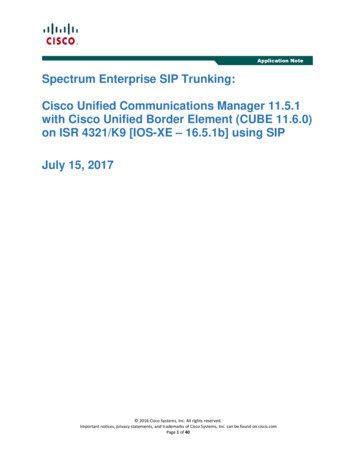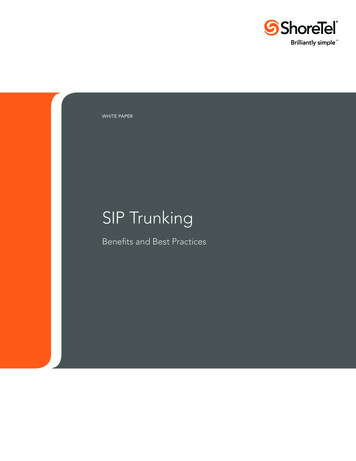
Transcription
WHITE PAPERSIP TrunkingBenefits and Best Practices
Table of ContentsAbstract . . . . . . . . . . . . . . . . . . . . . . . . . . . . . . . . . . . . . . . . . . . . . . . . . . . . . . . . . . . . . . . 31 What is SIP trunking . . . . . . . . . . . . . . . . . . . . . . . . . . . . . . . . . . . . . . . . . . . . . . . . . . 42 The benefits of SIP trunking . . . . . . . . . . . . . . . . . . . . . . . . . . . . . . . . . . . . . . . . . . . 52.1 Calculating the investment ROI . . . . . . . . . . . . . . . . . . . . . . . . . . . . . . . . . . . . . . . . . 52.2 Bandwidth utilization . . . . . . . . . . . . . . . . . . . . . . . . . . . . . . . . . . . . . . . . . . . . . . . . . 62.3 Flexibility to add new lines . . . . . . . . . . . . . . . . . . . . . . . . . . . . . . . . . . . . . . . . . . . . 82.4 Least Cost Routing (LCR) . . . . . . . . . . . . . . . . . . . . . . . . . . . . . . . . . . . . . . . . . . . . . . 92.5 Making IP-to-IP calls when possible . . . . . . . . . . . . . . . . . . . . . . . . . . . . . . . . . . . . 102.6 SIP trunking – the stepping stone to higher productivity . . . . . . . . . . . . . . . . . . . 113 SIP trunking infrastructure . . . . . . . . . . . . . . . . . . . . . . . . . . . . . . . . . . . . . . . . . . . . 123.1 The PBX component . . . . . . . . . . . . . . . . . . . . . . . . . . . . . . . . . . . . . . . . . . . . . . . . 123.2 The enterprise edge component . . . . . . . . . . . . . . . . . . . . . . . . . . . . . . . . . . . . . . . 143.3 The service provider component. . . . . . . . . . . . . . . . . . . . . . . . . . . . . . . . . . . . . . . 173.4 Trunk centralization and virtualization. . . . . . . . . . . . . . . . . . . . . . . . . . . . . . . . . . . 184 Interoperability . . . . . . . . . . . . . . . . . . . . . . . . . . . . . . . . . . . . . . . . . . . . . . . . . . . . . 184.1 SIP Standards . . . . . . . . . . . . . . . . . . . . . . . . . . . . . . . . . . . . . . . . . . . . . . . . . . . . . . 194.2 Interoperability . . . . . . . . . . . . . . . . . . . . . . . . . . . . . . . . . . . . . . . . . . . . . . . . . . . . . 195 Security considerations for SIP trunking . . . . . . . . . . . . . . . . . . . . . . . . . . . . . . . . . 205.1 Threats . . . . . . . . . . . . . . . . . . . . . . . . . . . . . . . . . . . . . . . . . . . . . . . . . . . . . . . . . . . 205.2 Importance of a stable platform . . . . . . . . . . . . . . . . . . . . . . . . . . . . . . . . . . . . . . . 215.3 SIP signaling . . . . . . . . . . . . . . . . . . . . . . . . . . . . . . . . . . . . . . . . . . . . . . . . . . . . . . . 215.4 Controlling media . . . . . . . . . . . . . . . . . . . . . . . . . . . . . . . . . . . . . . . . . . . . . . . . . . . 226 Quality and reliability issues . . . . . . . . . . . . . . . . . . . . . . . . . . . . . . . . . . . . . . . . . . 226.1 QoS – Different service provider approaches . . . . . . . . . . . . . . . . . . . . . . . . . . . . 226.2 Prioritization of voice traffic . . . . . . . . . . . . . . . . . . . . . . . . . . . . . . . . . . . . . . . . . . . 236.3 Call admission control . . . . . . . . . . . . . . . . . . . . . . . . . . . . . . . . . . . . . . . . . . . . . . . 236.4 Poor voice quality can be a client problem, or based on the internal LAN . . . . . . 246.5 MPLS . . . . . . . . . . . . . . . . . . . . . . . . . . . . . . . . . . . . . . . . . . . . . . . . . . . . . . . . . . . . . 246.6 Reliability of SIP trunks . . . . . . . . . . . . . . . . . . . . . . . . . . . . . . . . . . . . . . . . . . . . . . 246.7 SIP Trunking may be more reliable . . . . . . . . . . . . . . . . . . . . . . . . . . . . . . . . . . . . . 257 Implementing SIP trunking with ShoreTel . . . . . . . . . . . . . . . . . . . . . . . . . . . . . . . . 268 Summary. . . . . . . . . . . . . . . . . . . . . . . . . . . . . . . . . . . . . . . . . . . . . . . . . . . . . . . . . . 27References . . . . . . . . . . . . . . . . . . . . . . . . . . . . . . . . . . . . . . . . . . . . . . . . . . . . . . . . . . . 27The SIP Connect Spec . . . . . . . . . . . . . . . . . . . . . . . . . . . . . . . . . . . . . . . . . . . . . . . . . . 27SIP Trunks - Benefits and Best PracticesPAGE 2
AbstractBack in the days of wireline telephony, when all phone calls went over the Public SwitchedTelephony Network (PSTN), businesses would purchase “trunks” –dedicated lines or abundle of circuits – from their service provider. Today the new model of “trunking” to IPenabled enterprises can result in lower telephony costs and a rapid return on investment(ROI) plus the opportunity for enhanced communications within the enterprise as well aswith vendors, customers and partners.A SIP trunk is a service offered by an Internet Telephony Service Provider (ITSP) thatuses SIP to set up communications between an enterprise PBX and the ITSP. A trunkencompasses multiple voice sessions – as many as the enterprise needs. While some seeSIP as just voice, SIP trunking can also serve as the starting point for the entire breadthof real-time communications possible with the protocol, including instant messaging,presence applications, whiteboarding or application sharing.The possibility for a rapid return on investment is a key driver of SIP trunk deployments.SIP trunking delivers the following benefits: .Eliminates costly BRIs (Basic Rate Interfaces) and PRIs (Primary Rate Interfaces) services. .Removes the need to invest in additional PSTN gateway capacity as you grow Reduces capital expenditures: edge devices offer a lower investment path in addingnew lines as they are typically cheaper per line than the corresponding PSTN gateway Optimizes bandwidth utilization by delivering both data and voice via the sameconnection Maximizes flexibility in dimensioning and usage of lines as you avoid having to buycapacity in chunks of 23 (T1) or 30 (E1) lines Provides flexible termination of calls to preferred providers; calls to anywhereworldwide can be made for the cost of a local call. Enables redundancy with multiple service providers and links.There are three components necessary to successfully deploy SIP trunks: IP-PBX with a SIP-enabled trunk interface, Enterprise edge device that supports SIP Internet telephony or SIP trunking service provider (ITSP).The productivity benefits that come with SIP and SIP trunking are also significant. Byextending the SIP capabilities of the corporate network outside the LAN, satelliteoffices, remote workers and even customers can use VoIP and other forms of real-timecommunications applications to break down barriers of geography to share ideas andincrease productivity.SIP Trunks - Benefits and Best PracticesPAGE 3
Customer premises equipment (CPE) based on the SIP protocol – SIP phones, IP-PBXs,etc. – has been around for some time. Now that SIP trunks have gained momentum, it isimportant to ensure that equipment works together. It is for this reason that standardssuch as SIPconnect have become so critical. SIPconnect was developed by the SIPForum as a set of best practices for interfacing an enterprise PBX implementation withan ITSP. It attempts to eliminate some of the unknowns and incompatibilities of mixingequipment from different vendors within a single environment.Like any application that opens the private network to the Internet, there are ways tomaximize enterprise security for SIP trunking deployments. One of the most effectivetechniques is to address SIP security the same way data security is addressed – at theenterprise edge. SIP servers and SIP proxy technologies offer maximum control over theflow of SIP traffic, enabling the administrator to ensure correct routing, apply verificationand authentication policies and mitigate Denial-of-Service attacks.Voice quality is not an issue with SIP trunking if proper Quality of Service (QoS) measuresare applied, such as over provisioning of links, and prioritization of voice traffic. Reliabilityis also a moot point because SIP trunks can be more reliable than the traditional PSTNdue to the failover solutions that can be implemented.1. What is SIP trunkingUnlike traditional telephony, where bundles of physical wires were delivered from theservice provider to a business, a SIP trunk allows a company to replace traditional fixedPSTN lines with PSTN connectivity via a SIP trunking service provider on an IP networklike the lefirewallSIP-enablingedge deviceLANLANComputersFirewallIP PhoneIP PBXComputersIP PhoneIP PBXFigure 1 - Two typical SIP trunking solutionsSIP Trunks - Benefits and Best PracticesPAGE 4
To take advantage of SIP trunking, the PBX must have a SIP-enabled trunking interface.As shown in Figure 1, it can be an IP-based PBX communicating to all endpoints over IP,but it may just as well be a traditional TDM PBX. The sole requirement is that an interfacefor SIP trunking connectivity is available.Utilizing the Internet, the ITSP provides connectivity to the PSTN for communication fromboth mobile and landline phones.The IP-PBX on the enterprise networks connects to the ITSP via an enterprise borderelement. The border element could be a SIP-capable firewall or a SIP-aware edgedevice, working alongside an existing enterprise data firewall (all these components aredescribed in depth in section 3).2. The benefits of SIP trunkingA large number of enterprises already use VoIP, however many are only using it forcommunication on the enterprise LAN. In this scenario, VoIP is being used solely as adirect replacement for traditional wire line telephony. For all calls made outside of theenterprise, a PSTN gateway at the enterprise edge is used. These businesses realizea solid return on investment (ROI) just by lowering administrative costs and the costsassociated with calls made within the company.With SIP trunking, the potential for ROI is even greater because SIP trunking takes theidea of VoIP a step further. The full potential for IP communications can be realized whenthe communication is extended beyond the corporate LAN.The cost effectiveness of a SIP trunk is such that by replacing an installation of a PSTNgateway/PRI with an edge device/SIP trunk, ROI may be achieved in a matter of months.For new installations a SIP capable edge device is most often lower in cost compared tothe corresponding PSTN gateway functionality.2.1 Calculating the investment ROIIt is almost impossible to calculate a “standard” ROI for a SIP trunking investment, asthere are far too many service providers that offer services under widely differing termsand conditions. Additionally, voice calling rates are often bundled with other servicesmaking it more difficult to parse them out separately.This section focuses on the fundamental parameters affecting the costs and theprinciples of how enterprises using an IP-PBX, moving from traditional TDM PRIconnections to SIP trunks, can achieve a rapid return on investment.SIP Trunks - Benefits and Best PracticesPAGE 5
One of the immediate ways SIP trunks reduce costs is by eliminating the need topurchase ISDN, BRIs, PRIs or local PSTN gateways or equivalent functionality. Sincethe voice traffic is now routed through the Internet connection to the ITSP, no localconnection to the PSTN is necessary at the enterprise location except for possible afew backup trunks for emergency calling. The gateways needed to connect to the PSTNreside with the ITSP.The devices required at the enterprise edge for SIP trunking are not only typicallycheaper per line than an equivalent PSTN gateway, but they also enable the wholebreadth of SIP-based real-time communication and therefore become a strategic devicein the future of enterprise communication.2.2 Bandwidth utilizationMaxPeak r of minutesTDMNumber of callsIn many organizations, both telephony and data capacity is underutilized. Telephonyusage patterns in many organizations are characterized by “busy” hours that see manycalls all the way down to almost no calls (e.g. after business hours). Data or Internet traffic,on the other hand, is for the most part characterized by “bursts” of traffic happeningthroughout a business day.Figure 2 - Typical bandwidth utilizationSIP Trunks - Benefits and Best PracticesPAGE 6
If we plot the data using time periods with the highest usage at the left and then indescending order, it becomes evident how much of the total capacity is wasted.Number of callsMaxTDMBoughtCapacityCapacity in useTime0MaxInternetData Mbit/sNeededCapacityWastedCapacityCapacity in useTimeslots0Figure 3 - Comparison of capacity in useIn practice, when compared to real-time communications (such as voice), data trafficis usually not as time critical. Combining the two communication types on the sameconnection will give maximum use of capacity. By applying the correct Quality ofService (QoS) settings, critical voice communication can be prioritized over the datacommunication at all times.Flexibilityto use extracapacity02811625Data Mbit/sNeededCapacityfor VoIPVoIP - number of callsBoughtCapacity0Data uses free capacity with the help of QoS settingsFigure 4 - The capacity you need when you need itWith a SIP trunking solution, the capacity you need when you need it is always available.Instead of dimensioning the telephony capacity for peak usage, it may instead bedimensioned for average usage, allowing the dynamics of QoS to make sure that voicetraffic always gets the capacity it needs. Voice traffic borrows bandwidth from data trafficduring peak usage times.SIP Trunks - Benefits and Best PracticesPAGE 7
2.3 Flexiblilti to change line capacityThe cost of adding lines with a SIP trunk connection follows a fairly linear pattern (i.e thecost is directly proportional to the number of lines).Monthly cost USD450035002500TDMSIP Trunk1500500110150200Number of linesFigure 5 - Costs to expand infrastructure, TDM vs. SIP trunksWhen an enterprise using a TDM solution needs to increase its capacity, it generallyhappens in increments of 23 (T1) or 30 (E1) lines. Each additional E1 or T1 span requires: New PRI subscription. New PRI connection on the IPBX (PSTN gateway or similar resource).When the capacity of the PSTN gateway resource and/or PRI connection is exceeded, it isnecessary to invest in an additional PSTN gateway resource and/or PRI subscription. Thisis true even if you only need one more line. Going from one E1/T1 to two always requiresadditional hardware and they can generally only be bought in increments of 23/30 lines.Even if you move from an E1/T1 to a higher capacity standard bundle like STM-1, thetermination hardware will need to be replaced. The SIP edge device does not have thesescaling issues.In a SIP trunk solution, the enterprise can increase capacity in increments of a single lineby: Purchasing additional software licenses for the edge device. Allocating a greater percentage of the bandwidth for voice. Only if the total bandwidthcapacity is used will the Internet data connection need to be upgraded.SIP Trunks - Benefits and Best PracticesPAGE 8
The opposite is also true – if line capacity needs to be reduced due to seasonality in thebusiness, it is just as easy to work with the service provider to turn off SIP trunks therebysaving money.2.4 Least cost routing (LCR)The use of IP makes it possible to cost efficiently use SIP trunks from multiple serviceproviders, depending on optimal availability and the best rates (capitalizing on time zonedifferences, geography etc.). In essence, the enterprise can become its own “MasterService Provider” with subscriptions to service providers in countries where they havethe highest calling volumes. By routing calls to the cheapest service provider based oncountry codes, for example, significant savings can be InternetPSTNITSPSESIP-capable firewallor SIP capable edgedeviceLANComputersIP PhoneIP PBXOptional back-upPSTN gatewayFigure 6 - Utilizing multiple service providersThese routing decisions can be made by the PBX or by the edge device. The fact that thisability can be built into the edge device means that low functionality PBXs can performrouting functionalities as well. By “outsourcing” this function to the edge device thePBX needs only to send the number as it is, and let the edge device act depending ondestination etc.SIP Trunks - Benefits and Best PracticesPAGE 9
Using multiple service providers provides a higher level of security and reliability: .Failover to secondary Internet service provider. .Failover to secondary service provider or back-up PSTN gateway.2.5 Making IP-to-IP calls whenever possibleToday, calls that could be transferred over IP end-to-end are connected through TDMconnections instead. These situations arise when calls are routed to a PSTN gateway.In essence, the true benefits of IP communications are not only unrealized, they aredefeated as quality can suffer due to multiple conversions of voice signals between theanalog and digital domains.ITSP SoftswitchIP TSPITSP gatewayPSTNITSP gatewayClass switchIP PhoneIPIP PBXIP PhoneTDMIPTDMIPFigure 7 - Transcoding from IP to TDMENUM (Electronic Number Mapping System, also known as Telephone NumberMapping) is a standardized address translation technology adopted by the IETF (InternetEngineering Task Force) using DNS (Domain Name Service) to link a phone number toa specific SIP address. This feature is used to automatically look up phone numbers todetermine if they match a known SIP address, allowing the call to be completed over theInternet (instead of transferring it to the PSTN). Since no traffic is placed on the PSTN,ENUM provides an additional means of cost savings for businesses that communicatewith other enterprises also using SIP. If the number is not found in the ENUM databasethe edge device will route the call to the service provider for termination to the PSTN.With the growing installed base of SIP-based IP-PBXs, the critical mass for widespreaddeployment of ENUM will soon be here. We expect that an increasing number of calls willbe transferred directly via SIP over IP between the calling parties instead of going overthe PSTN.SIP Trunks - Benefits and Best PracticesPAGE 10
2.6 SIP trunking – the stepping-stone to higher productivityAlthough it is more difficult to quantify, the productivity gains that can be achieved byutilizing SIP trunking can be significant. Introducing SIP-based real-time communicationhas a tremendous
SIP Trunks - Benefi ts and Best Practices PAGE 6 Figure 2 - Typical bandwidth utilization Time TDM Internet Max Max Time Bought Capacity Number of calls Number of minutes 0 0 Peak hour Bursty One of the immediate ways SIP trunks reduce costs is by eliminating the need to purchase
